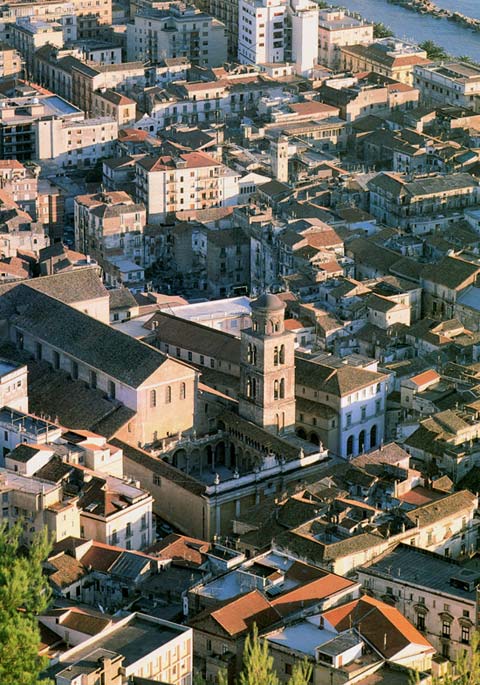
Salerno Cathedral
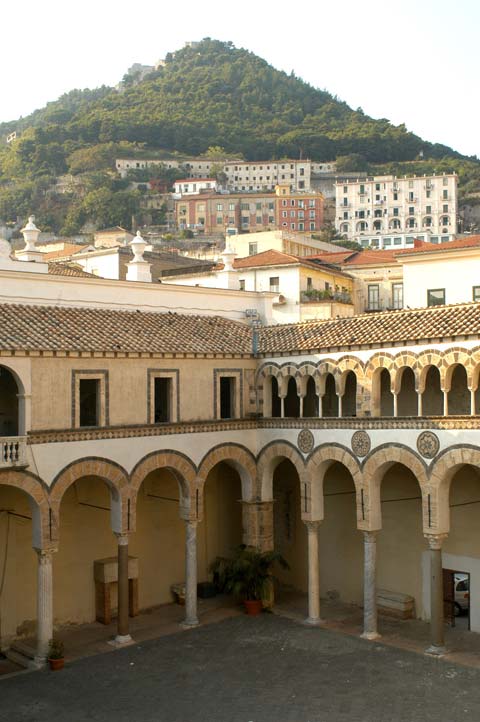
Salerno Cathedral - Atrio
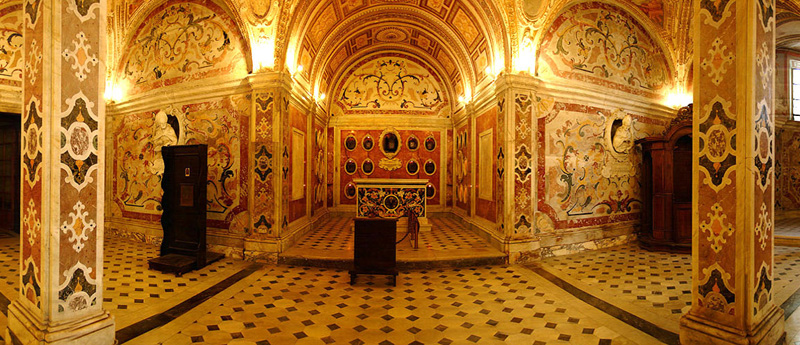
Salerno Cathedral - Cripta

Salerno Cathedral
Salerno is a fascinating example of what the Mediterranean has to offer all those who wish to have a closer knowledge of it. The town presents itself as a friendly comunity to visitors and tourists from all over the world.
Over the last few years the town council has improved its urban aspect and recuperated the social – economic functions of the area: ancient monuments and churches have been restored: new parks and gardens have been opened in various town quarters; roads and squares have been replenished with plants and benches and lit by ornate street lamps, many spaces have been retrieved for artistic, cultural and recreation activities; sports facilities have been increased with the building of new structures such as the Arechi Stadium. Many projects have been carried out to improve the surroundings and standard of living in certain parts of the town.
One can see the many traces of ancient history mixed with the artesan shops and places of entertainment where people throng, in the old town of Salerno which is both quite extraordinary and charming. The recovery of the old town was accomplished thanks to the urban project financial funds which have enabled the discovery of artistic and cultural treasure. Today one can read the town’s history merely by looking at the alleys and squares, the churches and buildings. One can perceive the course of events which have followed, a testimony of the flourishing economic, social and cultural splendour of the past centuries.
Nightlife takes place right here in the old town. The town hall has made the opening of many restaurants and places of entertainment possibile. At weekends the many pubs are filled with youngsters till the early hours. In the summer however, people prefer the fresh air of the seafront which is just a few metres away. The coast is also not short of discoteques and places of entetainment.
There is very little information regarding the origins of Salerno, although we are lead to believe that the area was inhabited from the early days. We know the Greeks brought to the vast plains, the cultivation of linen and wheat crops, olives and fruit, whilst the Etruscans brought the textile, ceramic and bronze industries.
In 197/4 B.C it became a Roman colony under the name of “Salernum”. The colony progressed, enriching its culture and its traditions, even during the Goti dominion. But only after the Lombardy conquest did it become the most flourishing centre of southern Italy.
In 786, Arechi II transferred the ducal seat of Benevento to Salerno to escape an attack by Carlo Magno and gain control of a strategic area between the coast and inland comunications. The Longobard prince fortified the town, which already possessed the castle on the Bonadies hill, with walls and towers, thus the new capitol became a principality seat and political centre.
During the reign of Arechi II, Salerno knew great splendour, becoming the seat of the oldest medical institution in western europe. The famous School of Medicine became known for its precious scientific discoveries fundamental for the present day.
On 13 th December 1076, the Norman leader Roberto the Guiscard, conquered Salerno, bringing an end to the old age domination. The Terracina Castle and Cathedral were built under Norman rule and great importance was given to science, in particular the School of Medicine. At the end of the century, a period of economical awakening was registered in the town with the coming of the Normans. Manfred, the son of Federico II, built the jetty which has still his name today and founded the annual fair of S. Mathew, the most significant of its kind in southern Italy.
Queen Margherita of Durazzo took up residence in Salerno after the Angoin conquest. She is buried in the cathedral in a monumental tomb, work of the famous sculptor Barbocio da Piperno.
After the XVI century most of the province of Salerno was ruled by the Princes of Sanseverino, strong overlords who attracted men of art and culture to the town. In the first decade of the XVI century, the last descendant of the Sanseverino's disagreed with the Spanish government, bringing ruin to the family which brought decline to the town.
The years 1656, 1688 and 1694 are painful dates for Salerno: plague and earthquakes produced numerous victims. A slow rebirth of the town began at the end of the Spanish empire, during the XVIII century, with the construction of many lordly properties and churches which can still be seen today in the old town.
In 1799, Salerno became part of the Neapolitan Republic. During this period, Gioacchino Murat demanded the closure of the School of Medicine. Religious orders were suppressed at the same time and many ecclesiastical properties were confiscated.
The town expanded outside the ancient walls. An urban development of the area began which continued after the Unity of Italy up to the second world war with the expansion of many suburban areas and the construction of both public and residential buildings.
In September 1943, Salerno witnessed the allied landings and from 12 th February to 17 th July 1944 was the seat of the Badoglio government. The aftermath of war was difficult for all Italians, but Salerno has slowly succeeded in growing and devolping into a modern european town.
The town hall was opened on 12 th April 1936. The building which was erected on four floors, covers an area of 5000 square metres with a covered walkway and a central courtyard which is taken up by a stairway “of honour” which divides into two leading to the official rooms. The design is typical of the fascist period. The Reception Hall or Salone dei Marmi as it is known today, is the most important of all, where in 1944 the first Council of Ministers and the United Nations Government met. Famous for its multicoloroured marble flooring and wall coverings in red, blue and gold mosaic, the same colours which represent the town hall, its opal lights shaped like fountains and its paintings by the Salerno artist Pasquale Avallone. A group of bronze statues sculptured by Gaetano Chiaromonte which were recently renovated are to be admired. Next to the Marble Hall, is the Sala delle Commissioni known today as the Sala Giunta (Council meeting room). On the opposite side of the Marble Hall is the Sala del Gonfalone covered by a glass square tiled ceiling. Following on from there is the reception room, the Mayor's, Vice Mayor's and General Secretary's offices. Nearly the whole of the ground floor is taken up by the Augusteo Theatre: a wide monumental hall characterised by a vaulted ceiling in reinforced cement. The illumination is provided by hundreds of small neon lights. The theatre seats up to seven hundred people. Recently restored and re – opened to the public after many years of inactivity, today it is a sought after place for all kinds of performances.
Salerno, with its 80,000 inhabitants, filled a role of great importance. The people of Salerno, aware of this exceptional moment felt proud to host the Italian government, a pride which showed in the way everybody competed, offering whatever was needed for the honour of the country.
Among the many problems that the italian government had to deal with during the winter and spring of 1944, some more than others can be recalled. Despite all difficulties, important risults were obtained. The food problem was solved by rationing. The re establishment of comunications and the rebirth of the University of Salerno took place. The school of Medicine had been suppressed during the French decade and on the morrow of Italian Unity, the last remains of the University of Salerno had been abolished by Francesco De Sanctis, Minister of Education and Rector of the University of Naples. A school of teaching (Magistero) is opened at Palazzo Pinto in Via Mercanti. The work carried out by Giovanni Cuomo from Salerno, first as under secretary then as minister of the Badoglio government was essential. The neapolitan accademic authorities rose up, underlining the lack of cultural traditions in Salerno. But the shortsightedness and the patrotism of the neapolitan body of accademics, supported by Adolfo omodeo, rector and Minister of Education were unable to prevent the re-opening of an important page in the cultural and social life of the town during the days of Salerno Capitol.
On 4 th June, during the liberation of Rome, Vittorio Emaunuele II entrusted the deputyship of the kingdom to his son Umberto, as previously estabilished. Badoglio was succeeded as President of the Council of Ministers by Vanoe Bonomi who continued to hold meetings up until August, when the government returned to its original seat after everything returned to normal in Rome. At this point the Salerno Capitol adventure ends. Salerno played its role as capitol for little more than five months. However in that short, dramatic and busy time, Salerno played an import part in the forming of the new Italian state. (Gabriele De Rosa, speech “Salerno Capitol” - convention Salerno 14.07.1994).
Throughout the ages, Salerno has probably been best known for its famous “Scuola Medica”, which has existed for over a thousand years, from medieval times until 1812. The first town “Hippocratica Urbs” which practiced and taught medicine without reference to astrology.
Legend has it that the School was founded by four Maestri: the Jew Helinus, the Greek Pontus, the Arab Adela and the Latin Salernus. The Salerno medical arts were born from a fusion of these four cultures, which came together in the heart of the mediterranean.
First news of the School of Medicine dates back to the 10 th century. Alfano I, Archbishop of Salerno from 1058 to 1085, renowned doctor, poet and philosopher wrote of his town: Tum medicinali tantum florebat in arte, posset ut hic nullus languor hobere locum : “Medicine was so advanced in Salerno that there was no place for illness”. Even though it's difficult to say, due to lack of reference, when the School was founded; it is certain that from the 10 th – 11 th century, the doctors in Salerno were well known even outside Italy.
Even women had an important role in medicine, which was unusual for the times. The most famous of these is Trotula, both obstetrician and midwife, who wrote articles on gynacology and obstetrics. The first document which mentions the school as an institution, is to be found in Federico II's constitution which was published in Melfi in 1231 and which declared: no one shall call himself doctor of medicine or shall practice medicine unless he has passed the exam in the Salerno School of Medicine and holds a diploma released by the teachers of the School testifying his medical ability. This because the teachers of Salerno came from distant countries bringing ancient traditions with them.
The great cultural re-awakening, born in the Benedictine monastery of Montecassino, was taken to new heights in the Abbey of San Benedetto in Salerno and had an important role in the development of scientific studies and medical practice.
Costantino the African, who remained in Salerno and Montecassino for ten years, was a key figure in the translation from Greek, Hebrew and Arabic, bringing Arabian knowledge to the area.
The basic doctrines of the “Corpus Hippocraticum” and the medical treatise remain those of Claudio Galeno. The first statute of the School dates to 1280, whereas the first degree was conferred only in 1441, when Alfonso D'Aragona authorised the creation of the “Collegium doctorum”, which is the same as todays “Medical Register”, which had the right to confer medical degrees.
The School continued to operate until 1811, when Gioacchino Murat suppressed it, sanctioning by law a situation which in fact already existed. Although the School continued to confer degrees, the actual cultural and scientific activities had already terminated.
Hearsay has it that Robert the Duke of Normandy, stopped in Salerno on his way back from the First Crusade because he needed urgent treatment to stop the infection spreading in his right arm after being wounded by a poisoned arrow. The doctors from the School decided that the poison must be sucked out by someone prepared to give his life for the Duke. Robert nobely refused, but during the night whilst he slept, his wife Sibilla, daughter of the Count of Conversano, sucked the poison from the wound, sacrificing her own life and saving his. In the same period, Robert's brother King William died in England. On receiving this news, Robert hastily left for England to claim the throne. On leaving Salerno he asked the doctors for a “vademecum”, a manual containing the principles of Salerno medicine. The original document the “Regimen Sanitatis” (Salerno Medicine), known through the ages as “De conservanda bona valetudine” “Flo medicinae Scholae Salerni” , was dedicated to the King of England.
Through the ages various aphorisms, rightly or wrongly, have been added to the original three hundred verses which were collected and commented on in the XIIIth century by Arnoldo of Villanova. There are many catalogues pertaining to the School of Medicine which list many herbs and plants, even though the original “Regimen Sanitatis” named only eighteen simple herbs as being beneficial, such as: mallow, mint, sage, rew, onion, mustard, violet, nettle, hyssop, chervil, inula, penny royal, nasturtian, selendine, willow, crocus, leek and black pepper. By “simple” we mean the part of the plant which has curative properties. The simple plants, according to the Salerno medical literature, were those which cured ills and protected health.
Some of the few remaining documents referring to the School of Medicine are on exhibit in the unconsacrated church of San Gregorio. Here one can fine documents which illustrate the activities of the School from the 11 th to 13 th century which was its most important period.
This was the time that made Salerno famous as an international centre of culture, translation and circulation of medical books which helped develope European medicine for at least four centuries.
Following what is written in an exisiting bibilography on coats of arms in Salerno, it is quite evident, like the passing of overlords or rulers, that the ensigns carried the symbols of reigning houses, but not the coat of arms of the town.
One needs to go back to 1574 to find documents in which the Municipality of Salerno is associated with a coat of arms. In fact the symbols of the town of Salerno is already present on the seal of documents related to that year regarding payments of guard duties at Torre dell'Annunziata. Already the figure of the benedicting Matthew is present and the motto Civitas Salerni is called Sancta, written with a shortened S which precedes Civitas.
In 1597 Mazzella describes the seal of the town so: Portrayed on a blue background is the Evangelist St. Matthew protector of the town, underneath are the arms of Hungary which were given to the said town by Charles II of Angio, King of Naples, after his wife Maria, only daughter of King Stephen succeeded to the throne of Hungary, after the aforesaid King Charles created the Principality of Salerno.
The choice of using St. Matthew as protector of Salerno on the coat of arms, dates back to 1544. In fact on 27 th June of the same year, Khair-ed-Din, a turkish pirate known as Red Beard, attempted to attack Salerno with his fleet. However a storm destroyed the fleet and Red Beard could not land. The people of Salerno attributed the outcome to St. Matthew and decided to place the saint on the coat of arms using the image of the Evangelist and Martyr St. Mattew with his right hand raised to bless and his left hand holding the gospel.
The coat of arms can also be seen on some monuments of the 1700s, in particular on the fountain of don Tullio, or the Esculapio, dated 1790 actually placed in the Town Hall Gardens; on the portal of the ex monastery Ave Gratia Plena Minore built at the beginning of the 1700s and the Nunziatella church opened in 1758. This last coat of arms, the only existing coloured one, has on the upper part a cross on a blue background and below three alternating gold and red stripes, thus using perhaps the Aragonese colours.
Since 1806, the history of all coats of arms is the same for all towns under the Reign of the two Sicilys, in fact according to the 263rd law of 1 st December 1806, it was stated that the only “seal” that could be used is the one of the Royal Crown around which every authority could engrave his own name so as to be distinguished from the others. Therefore even the rubber stamps of the town of Salerno carry the abbreviated coat of arms of the realm which the above law describe as a shield with the emblem of the Reign of Naples with two gold horns of plenty and a silver dolphin on a pale blue background on the upper part and the emblem of the Reign of Sicily in silver on a gold background on the lower half. In the middle of these symbols is the shield of the French Empire adorned by the Imperial Crown.
The same lay out is confermed by the Bourbons, first with a letter dated 10 th June 1815, then with three decrees: decree number 4069 dated 21 st December 1816, decree 15 th March 1817 and decree number 1082 dated 20 th January 1818 on the base of which, the coat of arms of the town and the Royal Seal will be added in an elliptic segment the indication ....., of the town to which the seal belongs.
With the decline of the Bourbons, the Superintendent of the Principality in a letter dated 11 th September 1860, invited the mayors to make arrangements for new coats of arms and seals to be assumed bearing the Arms of the Illustrious House of Savoia with the epigraph Vittorio Emanuele King of Italy.
Following the Unification of Italy, the coats of arms of the towns return, as one deduces from a letter to the Government of the Province dated 15 th June 1861, which prompted the Town of Salerno to supply a copy of the Municiple coat of arms, even though it was only for an exhibition to be held in Florence that same year.
It is in 1865 when a law dated 20 th March enforces a series of regulations of the Sabaudo Reign, among which the Law on Town and Provincial Administration dated 23 rd October 1859 which gives precise indications to be adopted regarding the coats of arms.
The towns had to make a request for the concession of a coat of arms in the form of a patented letter written on parchment upon which a minature illustrated figure should be drawn, to be described in the contents of the same letter in artistic terms.
From the archives it would seem there was no written request for recognition in those years although there is a pressing request from the Printer and Editor Gaetano Longo for a copy of the coat of arms for his work “Illustrations of the main towns of Italy” and a water color of the coat of arms graphically similar to one partly used towards the end of the 800s on stamps and headed paper. But it should be revealed that the first examples of headed paper and rubber stamps of the Town do not have the symbol of Saint Matthew, as for example the coat of arms of the town in the Municiple Theatre opened in 1870. On the upper half of the coat of arms is a star on a blue background and three alternating gold and red stipes on the lower half.
For some years both the seals with the star and Saint Matthew appeared together on the coat of arms. After 1880 the figure of Saint Matthew appeared on the seals and headed paper of the Town.
The symbol of Saint Matthew is omitted in 1941 in some municiple services such as the Dairy and on the trams.
The town requests the first official recognition of a coat of arms on 3 rd February 1939, following a decree number 442 of 20 th March 1924 which absolutely forbid towns to use Coats of Arms, Emblems, seals and stendards which had not been legalized by the Heraldic Commission of the Reign (it came under the Council of the Presidency in 1923) and later laws dated 1928 and 1933 demanded that the emblem and the seal of the town should assume the Fascist Fasces on the Heraldic Figure.
The artist Pasquale Avallone was called to design our coat of arms and stendard, but a note from the Prefecture dated 30 th April 1940 communicated the decision of the Heraldic Commission to carry out some alterations to the proposed coat of arms. 1° the elimination of the walled in crown above the figure of St. Matthew; 2° the right hand of the Saint to be shown in the act of blessing instead of holding a pen; 3° The lower part to be in red with three silver stripes instead of gold and red.
The modifications carried out, but mainly those referring to the changing of the colours, were not accepted by the Municipality who maintained the towns people were attached to their stendard, with its traditional red and gold colours reproduced in the Town Hall, the Prefecture and all pubblic buildings both modern and old in Salerno.
The final approval of our Coat of Arms and Stendard as well as the recognition of the title of the Town was decreed by the President of the Council of Ministers on 23 rd June 1949, which recited:
The Town of Salerno may determine who has the right to use the Coat of Arms of the stendard described on the attached sheets as follows:
The aforesaid is to be mentioned in the Heraldic Book.
The coat of arms was redesigned in digital form by the firm Assegno Associati in 1996, about fifty years later. The Town Hall passed a resolution on 26 th November 1996 adding the words HIPPOCRATICA CIVITAS to the one still in use, to recall the distinguished Salerno School of Medicine, which for centuries has been the pride of the towns' people.
The St. Matthew Cathedral founded by Roberto the Guiscard and consacrated by Pope Gregory VII, was officially opened in March 1084. The present structure dates back to the earthquake of 5 th June 1688, when it was completely rebuilt. The main entrance has been altered and the courtyard is surrounded by a covered walkway supported by twenty eight plain columns with arches and a series of Roman tombs around the walls. On the southern side of the cathedral stands the bell tower which dates back to XII century. One enters the cathedral through a bronze byzantine door. In the centre nave are the celebrated amboni decorated with sculptures and mosaics dating back to the last decade of the XII century. In the Treasure Chapel, one can admire the many gothic relics including St. Matthew's arm and the statue of the Salerno Martyrs. The crypt is situated under the main alter. The crypt area is made up of nine rows of three bays with a cross shaped vault which resta on pillars. In the 12700s it was restored by Domenico Fontana, who designed the vault in alternate octagonal and circular sections surrounded by stuccoes and paintings. He designed the double main alter where two masses can be celebrated simultaneously.

Salerno Cathedral

Salerno Cathedral - Atrio

Salerno Cathedral - Cripta

Salerno Cathedral
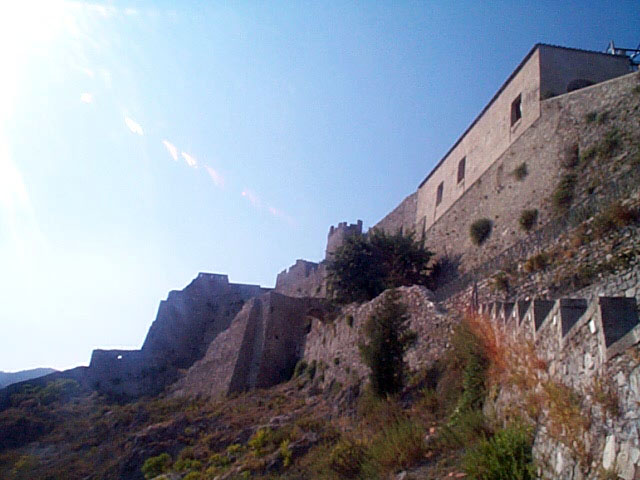
Arechi Castle
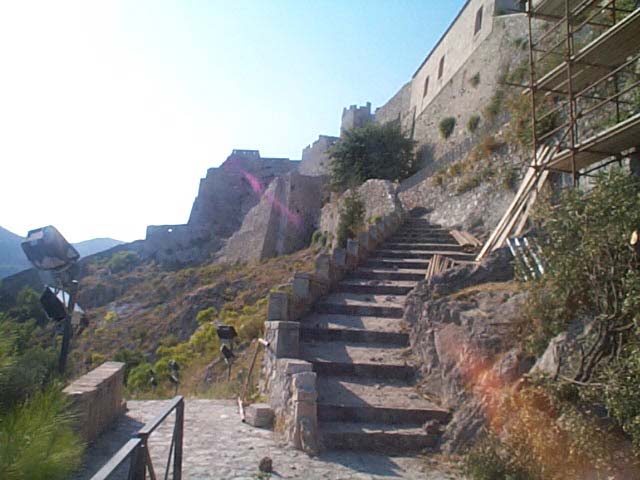
Arechi Castle
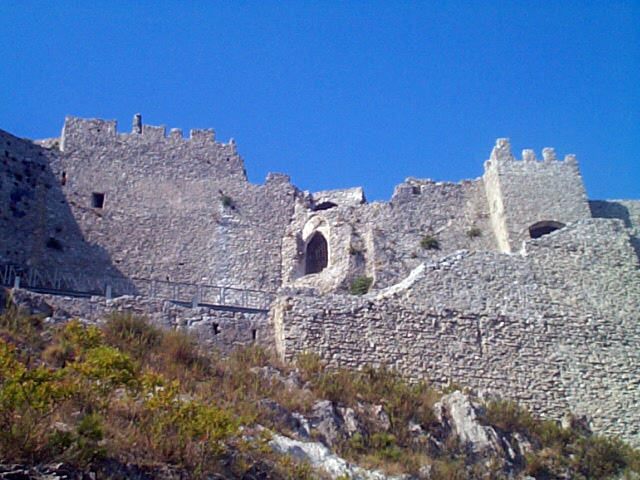
Arechi Castle
The fort dating to 1563 was part of a defensive system against the Saracen invasions. According to historians the name was given to the fort following a Saracen massacre which took place on the headland in 872.
Originally the fort stood on the headland but following the construction of the highway number 18, it was cut back. The presence of iron in the walls and its position lead one to believe it was a so called “cavalry tower”. Men on horseback who lived in the tower would warn the towns people in case of attack. Around about the 1600s the tower was used by Ippolito from Pastena as a base during the anti Spanish revolt against the french invasion, thereby preventing Salerno from surrendering.
During the last war, the fort was used as a gun post; traces still exist today.
Today the Fort is used for cultural events.
The archeological site which is surrounded by a wall covers an area of about 4,500 square metres.
It was turned into a park in the 1950s and the more relevant remains were brought to light.
About half of the area is covered by remains of buildings dating back to VI century B.C. Later it was inhabited by Etruscans, Greeks and indigenous peoples.
There are also important remains of a Sannitic Necropolis made up of eight tombs in grey local stone, two of which have spaces with funeral beds complete with head rests, some triangular shape others cylinder shape.
On the western side there is a cistern, vats for containing clay, an oven, wells and canals as well as paved spaces which testify that the area was used to work local clay between the VI and V century B.C, a theory which is also confermed by the presence of moulds, scrapers and pottery remains.
The annual digs help to coordinate the cronological sequence of the area which has brought to light finds from the VIII century B.C, which prove even more that there existed an urban organisation in the VII century B.C. Many exhibits are kept in the Museo Provinciale.
The first Benedicine Convent dedicated to Saint Sophia was founded towards the end of the X century in Via Trotula de’ Ruggiero, north west of Piazza Abate Conforti.
First it housed monks, then two centuries later it was given to the nuns of the same order. In 1592, the monastery was entrusted to the Jesuit Priests to educate young boys. Pope Clement XVI suppressed the order in 1778 and entrusted the religious structure to the Carmelites. In 1807, during the napoleonic requisition and up until 1938, the convent served as a civil court. Following the construction of the actual law courts it became a state school.
The large building has recently been restored after years of neglect.
The Addolorata Church was built by the Jesuit priests who occupied the Santa Sophia Monastery towards the end of the XVI century.
The front of the structure is adorned by stuccowork and the actual staircase which divides into two flights of steps with a central balustrade was added in the 1800’s. Inside the church one can admire a central nave with two side chapels; a transept with dome, a high altar and choir stalls. Overhead is a barrow vault. The spacious church has interesting stucco and maiolica decorations and artefacts in marble.
The square, the church and the S. Sofia Convent have been restored by the council with the help of the Urban Project Community funds.
Today the church is used today as an auditorium, conference and exhibition hall. Special facilities for the disabled have been installed in Via Tasso.
According to some historians, seat of the Roman Salernum Forum, was for centuries the centre of political, economic and religious life. Most of the buildings facing the square date back to medieval times: the Santa Maria Maddalena Convent which today is the Torquato Tasso Boarding School, The Santa Sofia Convent and the Church of the Addolorata, the State Archives which was once a court during the Aragonese period and judicial court and prison up until 1934. In the 600s, the Addolorata church was built, the ancient Santa Sofia Monastery was extended, plus many other buildings were demolished, therefore a transormation of the square took place, making it what it is today. Later other stately homes were built which gradually extended to Via Tasso where the aristocracy and middle classes lived from the 700s onwards. One understands the importance of the area from the names: Largo della Real Udienza, Largo Real Liceo and Largo Corte D’Assise.
Originally the two squares were joined. Once the reknowned St. Matthew’s fete which was one of the most prestigious of its kind in southern Italy, was held here. The event attracted merchants from all round. Executions also took place in the large square.
On the right hand side of the Portanova Square one can still see a wall painting dating to the late 600’s, the so called “Lady of Grace” where the condemned, stopped to say a last prayer.
On the opposite side of the square stands the San Pietro in Vinculis church which in the past was seat of the confraternity who gave assistance to the prisoners.
Between the two squares one can admire the “Porta Nuova” (New Gateway) designed in 1754 by Ragozzino. On the top of the gateway sits a statue of St. Matthew, patron saint ad protector of Salerno. The work was carried out in 1756 by the sculptor Francesco Pagano.
The octagonal shaped Flavio Gioia Square, commonly known as “La Rotonda”, was improved in 1997 with the addition of a sculpture of two dolphins, work of Roberto Dalia which symbolise “Salerno as a marittime town”.
The two squares which were recently restored occupy an important place where people stroll or where important events are held.
The Monumental Complex of San Pietro a Corte is the most important Longobard construction in Salerno. The monumental remains represent the main architectural emergences of Medieval Salerno and asregards the Longobard architecture in Europe, they are the only example of a Palace building complex. It was the most prestigious seat of the Longobard Court in Campania. It was built by the duke of Benevento, Arechi II who, in 774, after the defeat of the Northern Longobards by Charles Magnus, after having been conferred the titulus of Princeps gentis langobardorum, transferred, for political and strategic reasons, his residence from that town, which was then capital of his dukedom, to Salerno, where he built a magnificent palatium. As regards its structure, the pilasters of the upper room (official room) stand on a frigidarium of a spa building complex dating back to the imperial age (the end of the 1st –beginning of the 2nd century a.C.), after reused as graveyard by the Cristian communities in Salerno, there important public personalities of the time were buried (vir spectabilis). From upstairs you could enter a large room which was probably the official room with an adjoining Palatine chapel. Over the following centuries (in 1567) this room was modified by the commendatory abbot, Decio Caracciolo, who added to it the present access great staircase, which can be seen from the entrance of Largo Antica Corte. Between the 13th and 16th centuries a chapel devoted to the cult of the Virgin Mary was made. Among the different uses it has had up to now, it was also seat of the Salernitan Medical School. In the future, when its restoration comes to an end, it will be the seat of a museum of the Longobard civilization of Southern Italy.
The Monumental Complex of San Pietro a Corte is presently managed by the Salernitan Archaeological Association, after a special convention stipulated with the Ministry of the Cultural Heritage and Activities- the Monuments and Fine Arts Offices of Salerno and Avellino.
This Complex participates into the project started by the Town Council of Salerno “Always opened Monuments”, because it is open all the year round (free entrance) from Tuesday to Sunday from 10.00 to 1.00 pm and on Mondays from 3.00 pm to 6.00 pm.
Free guided tours around other monuments included in the cultural tour provided by the project are also managed by the members of the Salernitan Archaeological Association at other info-points (Minerva Gardens-church of St.Salvatore de Fundaco).
On his death in 1702, Fabrizio Pinto left his inheritance, which included Palazzo Genovese to the Scalzi Carmelite Order. Not having sufficient funds to restore the ancient building the Order left it to Baron Matteo Genovese. The re-construction of the 18th century building was assigned by Genovese to the neapolitan architect Gioffredo. The building which for a long time was allocated as a school, was recently restored. The ground floor of the building is being temporaily used for exhibitions and showings.
Worth mentioning as one of the most important buildings of the 600s is Palazzo D’Avossa. Originally the structure belonged to the noble Della Calce family. In the 1300s the D’Avossa, an equally noble Salerno family were obliged to leave Spain to escape unjust persecution. The building has an entrance with a barrow vault which opens into a courtyard with statues in marble placed in niches. The courtyard once housed the old stables. On the right hand side of the courtyard is an elegant open stairway which leads to the upper floors. The last two floors were added later on. The majestic stairway walls reproduce episodes of “Jerusalem Freed”. The restoration work was carried out in the first half of the 700s by Ferdinando Sanfelice, one of the most important artists of the time.
Situated in Piazza Alfano I in the old town, Palazzo Giannattasio occupies an important place among the noble edifices, both for its position and for its architecture. The building as we see i today, was restored during the second half of the XVIII century. The property which was once owned by the Della Calce’s was bought by the Giannattasio family who originally came from San Cipriano Picentino. The family coat of arms can still be seen on the keystone over the portal and on the pillars of the terrace of the noble appartment which face onto the cathedral. The portal is simple with no decoration which has no connection with the baroque style. The first two floors open in the centre onto two wide balconies, decorated with a chiaro scuro effect. The eastern corner of the building is decorated with a stuccoed frieze. There are many areas in the courtyard which were once used as storage space, stables and service facilities.
Palazzo Copeta is situated in Via Trotula de’ Ruggiero in a aprt of the old town known as “Planum Montis”. The family who originally lived there were not of nobile origin, although one of its members had been a bishop, as one can see from the coat of arms over the doorway. Facing west towards the sea, the stately home dominates the whole gulf. Its structure and decorations refer to the architectural culture of the Neapolitan 1700’s. The ground floor where once there were stables, a carpenter’s shop and storerooms, opens into a charming inner courtyard surrounded by a decorated walk - way with a central fountain. Palazzo Copeta is along with the stately homes Conforti and Ruggi, one of the most elegant residencies built on the site of the ancient cemetery of the Santa Maria Monastery in the old town during the XVIII century. A cluster of monumental buildings surround the Montone Square now used for open air performances.
The seafront was completely restored in 1990 by the town council.
It is one of the many places which represents the town because both in Summer and in Winter many people love to stroll along beside the sea.
It is one of the longest promenades in Italy, designed only for pedestrians and forever in continuous expansion; the intention is to extend it to the southern end of the town.
Along the seafront, which begins on a level with the old town, one can find many places of restoration and elegantly designed park benches.
The gardens planned in 1874 by the architect Casalbore were once one of the main links between the old town lying to the north east and the urban centres - in particular Naples.
The fountain known as “don Tullio” or “Esculapio”, was designed in 1790 to supply refreshment to those coming from the sea or wayfarers. Over the years the gardens have been filled with statues of historical background and rare plants so becoming a pleasant meeting place and retreat. But like all places in need of care and attention, they have seen moments of neglect alternated with moments of splendour.
Recently a project for the botanical and architectural restoration of the gardens was carried out. The project consisted of the expansion of the flower beds which were completely redisigned as botanical gardens with new and rare mediterranean plants. The main fountain and other monuments have also been restored. The pathways have been redisigned and the paving which extends to the Verdi theatre has been redone so that now the two important places are connected by a charming pedestrian area.
Recorded music can be heard throughout the gardens.
Situated in Via Ferrante Sanseverino (the gardens are easily reached by a public lift connects Piazza A’Aiello – Fornelle quarters to Via Tasso).
Open to the public on Tuesdays, Thursdays and Saturdays from 10 till 1 p.m and Saturday afternoons from 5 til 9 p.m. Bookings can be made by phone (089-2526214) during office hours (8 a.m till 2 p.m) or by fax (089-2526213) or by sending an E mail (risorsecomunitarie comune.salerno.it).
Historical notes:
The Minerva Garden was the first botanical garden in Europe for cultivating plants for therapeutical use. Situated in
the heart of the old town, close to the Fusandola stream and the ancient medieval walls, the garden appears as a
terraced – walled orchard. The elements which date back to the 700s are very enchanting: a fountain on a terrace and
the long terraced stairway bordered by stuccoed pillars leading to a belvedere, the whole covered by a pergola. The
canny way of distributing water by means of troughs and fountains on every terrace, the type of climate favoured by the
exposure to the sun and lack of northerly winds has helped maintain the garden over the centuries. The garden owned by
Mathew Silvatico eminent doctor and author of the Libercibalis et medicinalis Pandectarum – a rare collection of
information on plants used for producing medicine, was a place of learning for the students of the School of
Medicine.
More information www.giardinodellaminerva.it.
The Mercatello park was officially opened on 6th February 1998 by Oscar Luigi Scalfaro – President of the Italian Republic.
Extending over an area of 10 hectares, it is one of the largest urban parks in Italy in proportion to the number of inhabitants. It unites three areas: Mariconda, Mercatello and Quartiere Europa. It has revitalized these areas which otherwise would have remained mere dormitory suburbs.
The characteristic aspects of the park are the small river which crosses it, the greenhouses and the rock gardens where one can view cactus plants donated to the town council by the Acquaviva Foundation, the artificial lake and the canal. A large space has been reserved for open-air performances.
The running of the refreshment kiosk has been entrusted to a group of ex-unemployed people. Work to complete the park is still being carried out.
The Acquaviva family collection of cactus plants was acquired by the town council in 1998. Dr. Osvaldo Acquaviva’s collection which is today patrimony of the town is the result of years of dedication. In order to protect and exhibit the precious collection, the town council have built a greenhouse in the park. A perfect setting from an estetic point of view and an excellent enviroment for the plants.
Six months were necessary for the planting, the up-keep of the species, the preparation of the soil, the positioning of the plants, the weeding and antiparasite treatment. An important collection from a quality and quantity point of view, some of which are extremely rare.
The town council have added to the already rare collection. The greenhouse has been surrounded by flower beds full of rare cactuses such as Agavi, Euphorbie, Echinocactus, Crassule, Chamaecereus etc., which show the visitor different types of extraordinary specimens kept in the greenhouses. Today the glasshouses in the park are among the few of their kind in southern Italy: a place of reference for botanists and garden lovers, a must for tourists and an oasis for the townspeople. The cataloguing of the specimens, together with constant care help to maintain the standard of the glasshouses in the park.
The “Terme Campione” situated on the Lungoirno near the site of the new courts, takes its name from an ancient thermal establishment which existed in the area.
It is commonly known as “Parco Pinocchio” because of a bronze statue designed by Antonio Petti.
Near the main entrance is a monumental fountain, a wisteria pergola, palm trees and artistic illuminations.
Secondary paths lead off from the main pathway which take you to a green area where there is a children’s playground.
There is an anfitheatre in the park as well as a building which houses bars, toilets and a hall.
In the middle of the park is a square with a fountain.
Next to the G. Costa School a wooden pergola and a wall have been added.
The Parco del Seminario is another green area along with the council gardens and parks of Salerno.
The park covers an area of about 30,000 square metres and accomodates an area where open air performances are held, seating about 800 people; a recreational area consisting of two courts for netball, tennis, volley ball and so on and a refreshment kiosk.
The area is equipped with paths for walking and jogging, with special mechanical facilities for the disabled. A music diffusion system and artistic illuminations complete the park.
The entrances to the park from Via Urbano II and Via Valerio Laspro have recently been restored. The latter being particularly because it has the largest sundial (2,60 x 1,20 metres) in Europe. Made of terracotta and ceramic from Ogliara, it was designed by Erika Beker and Marco Baccilega.
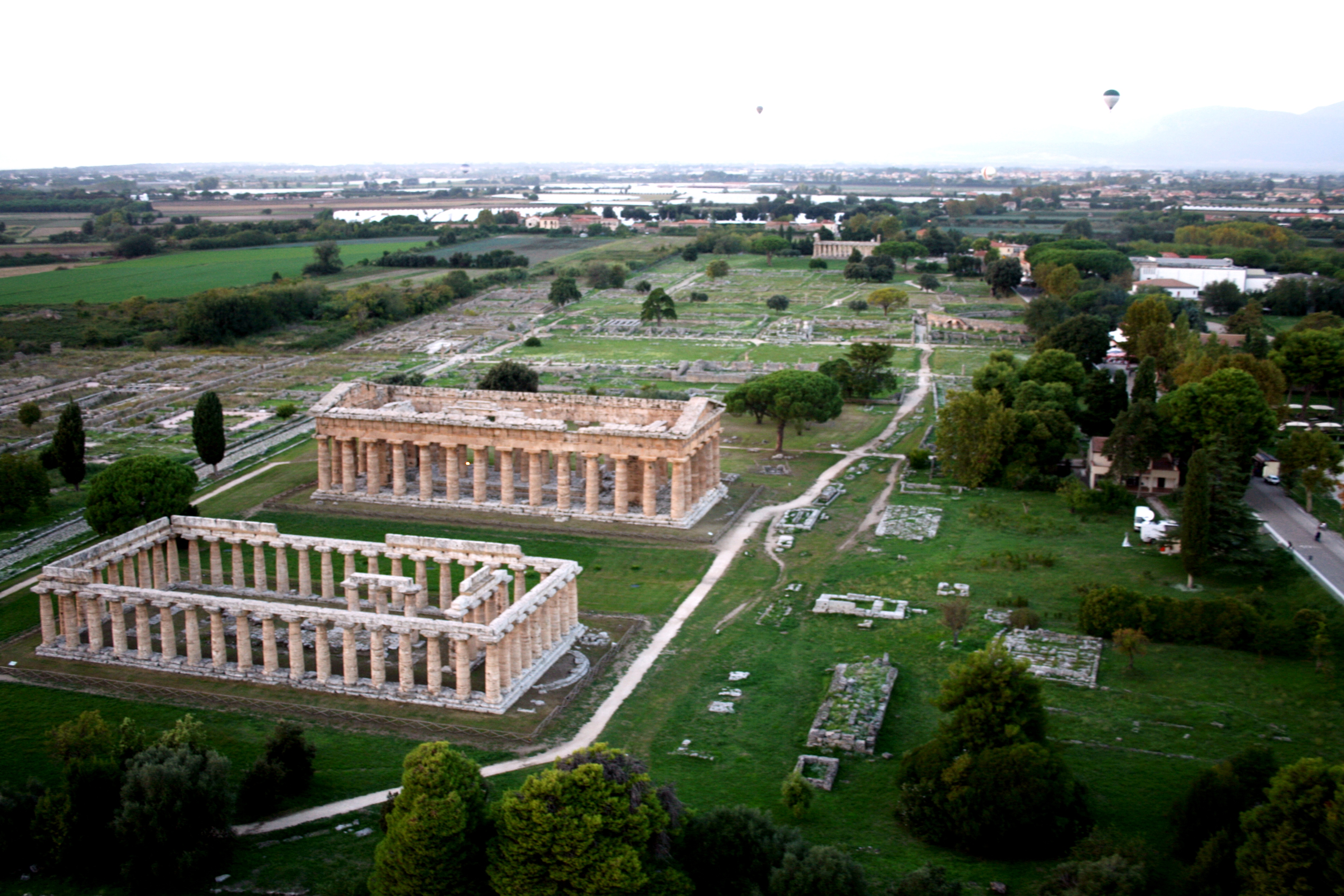
Paestum View
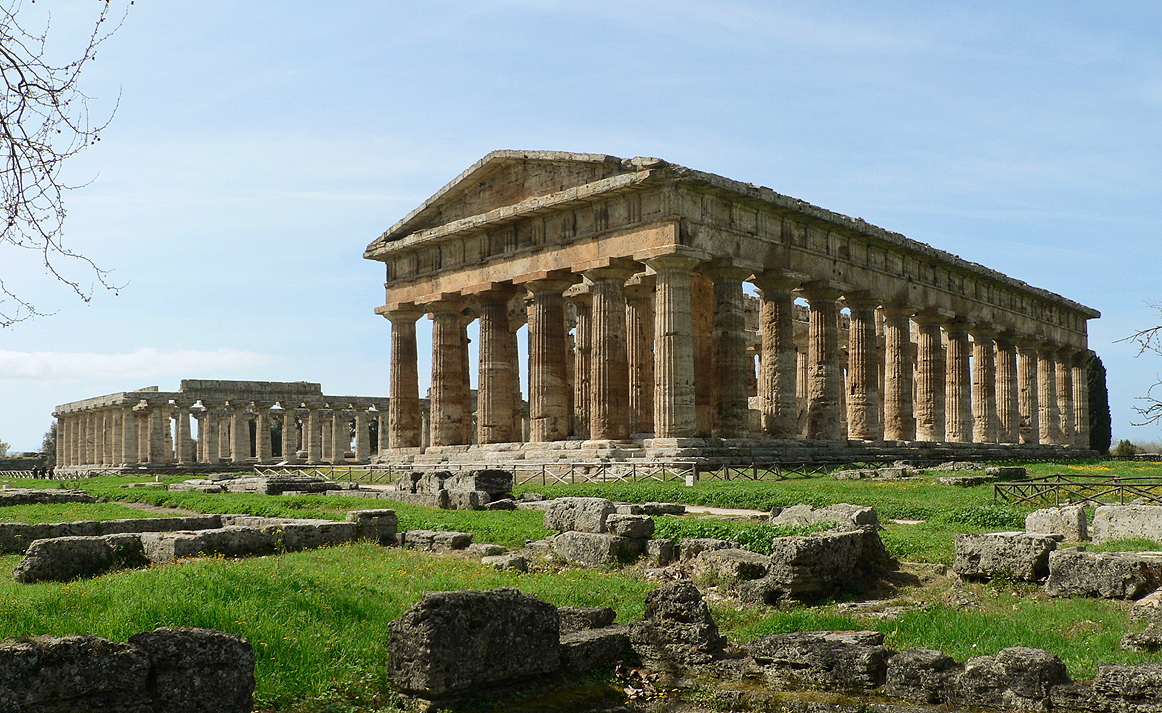
Paestum Temples
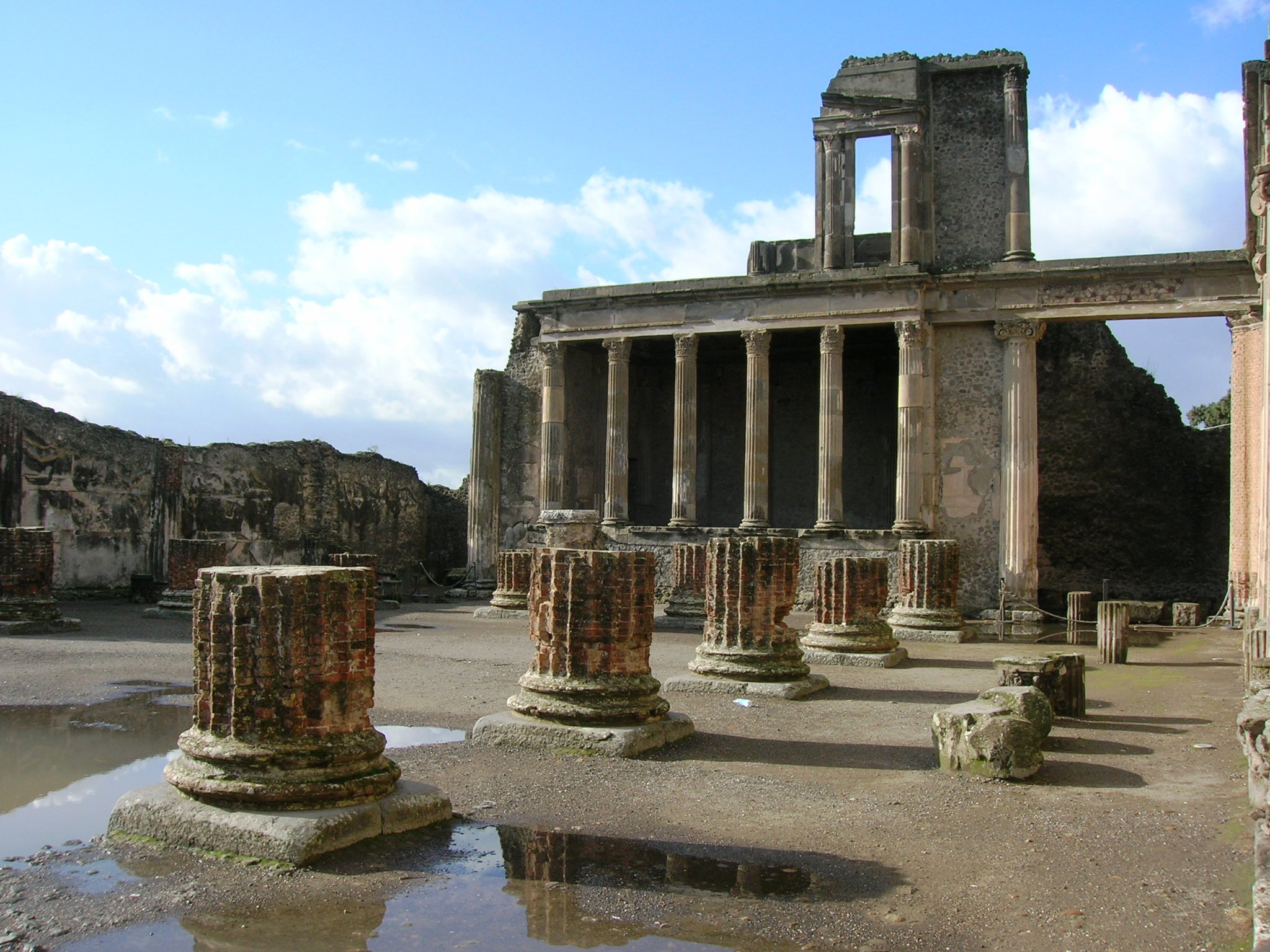
Pompei
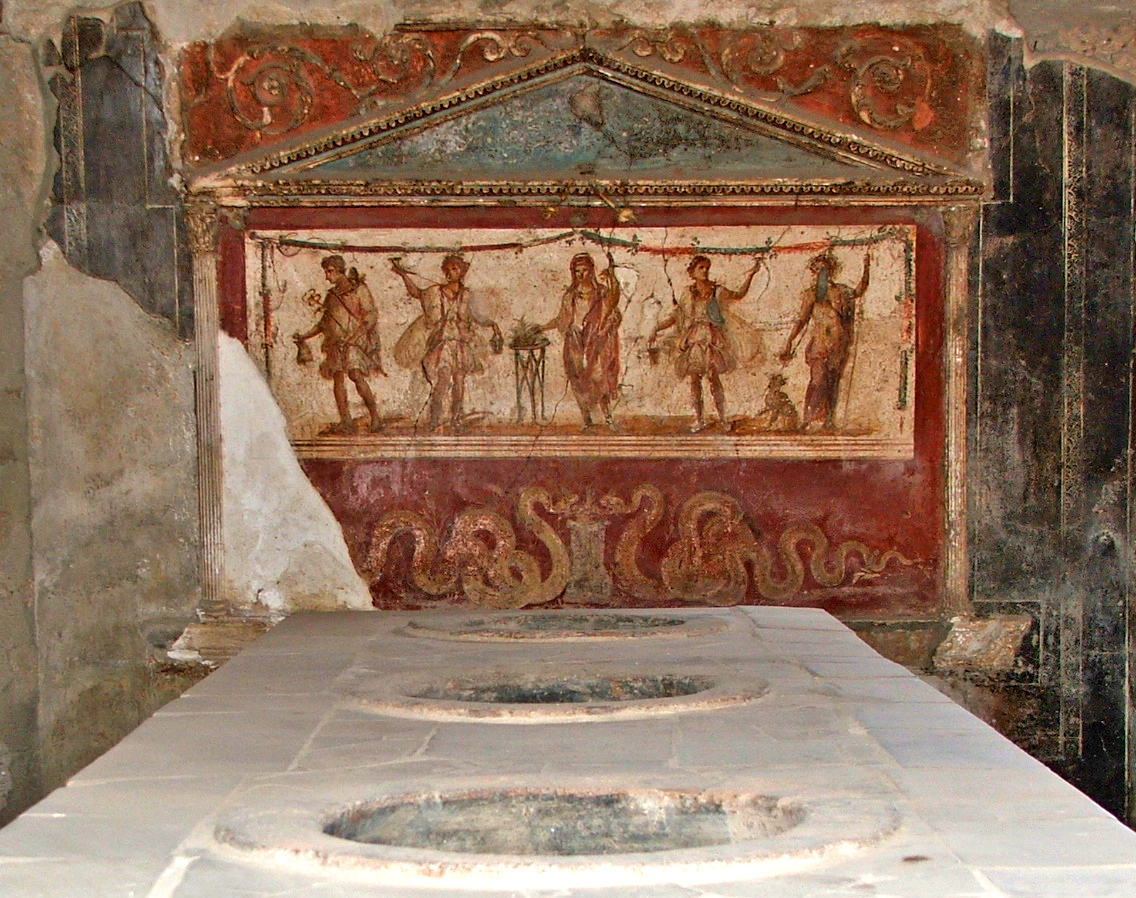
A thermopolium
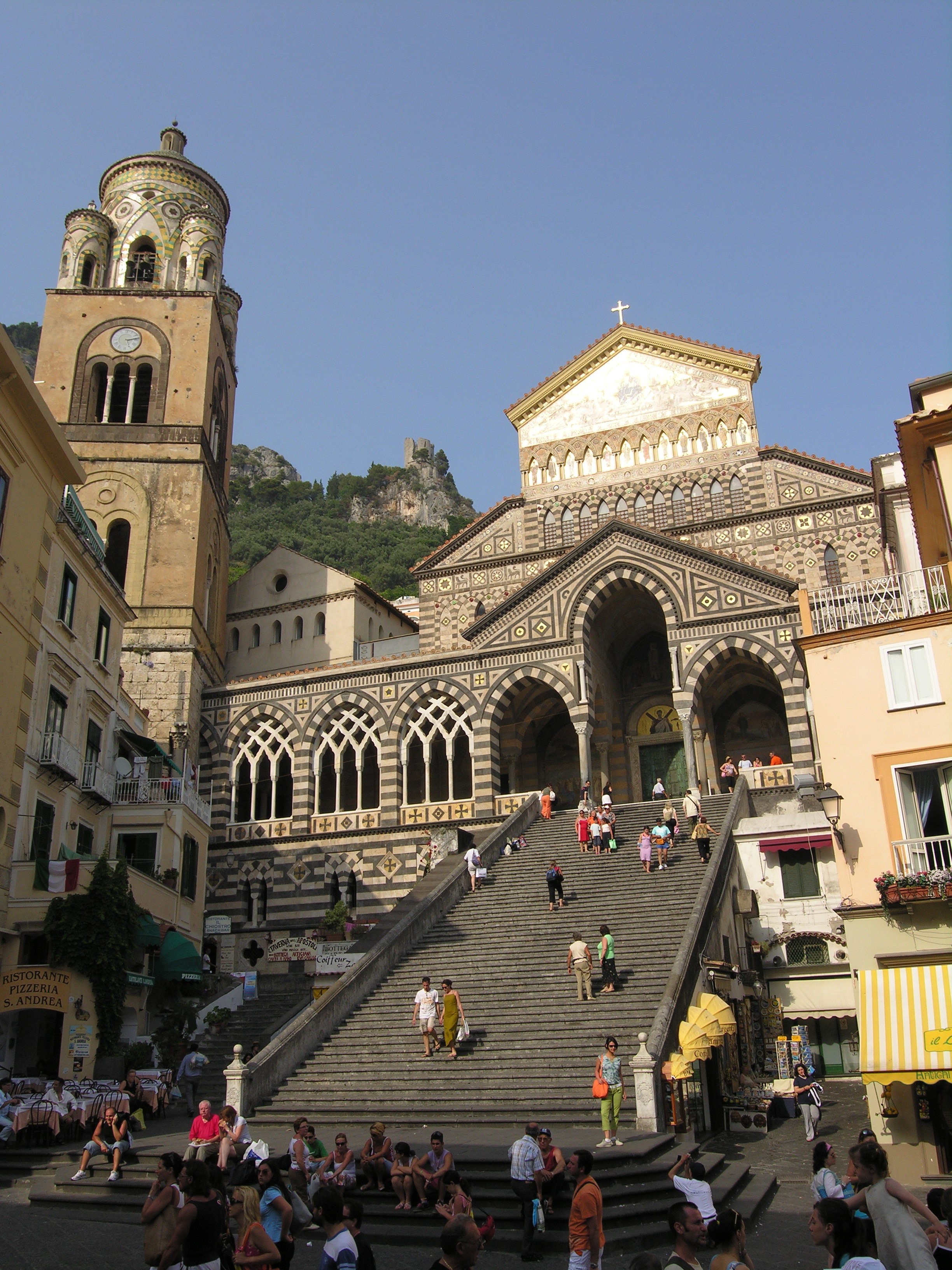
Amalfi Cathedral
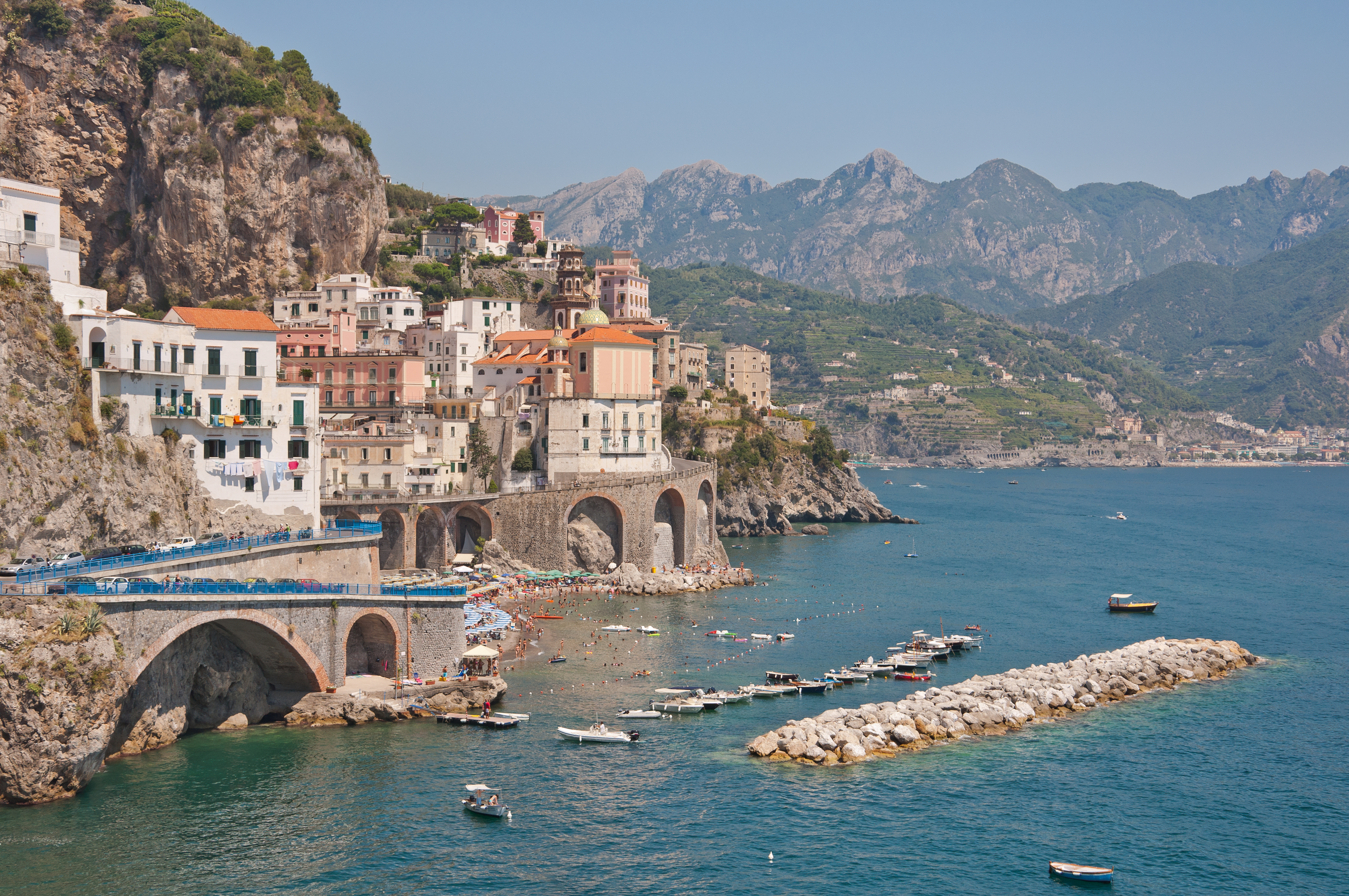
Amalfi View